Cyclamen look difficult, but are easier to care for than you might think. But, since their growing season is different than it is for other plants, many people struggle to keep them alive. Don’t worry, in this detailed guide I will show you all you need to know so they will thrive for years to come.
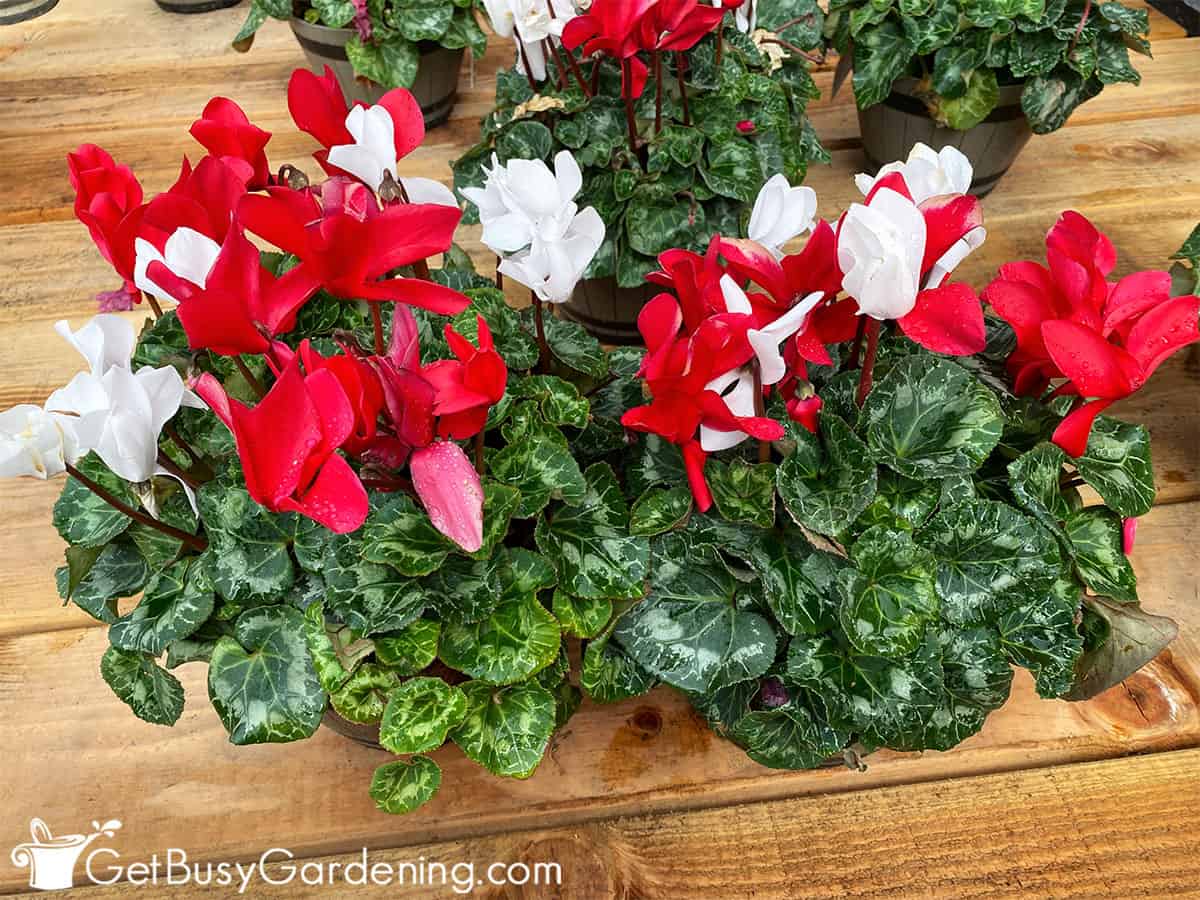
Though they have a reputation for being fussy, cyclamen plants are actually surprisingly easy to grow once you know their care requirements.
They are much tougher and hardier than they look, and do equally well in the garden as they do indoors. Plus they come in a wide variety of shapes, sizes, and colors, which makes them fun to collect too.
The good news is that, with the right cyclamen care, you can keep your plant for decades, and get it to bloom over and over again.
Continue reading to learn all you need to know about how to grow cyclamen in this detailed guide. Below you’ll find details about watering, fertilizer, soil, humidity, flowering, light, and much more.
Cyclamen Quick Care Overview
| Scientific name: | Cyclamen |
| Classification: | Tropical plant |
| Common names: | Cyclamen, others vary by variety |
| Hardiness: | Ranges fro zones 3-11, but varies by type |
| Temperature: | 50-70°F |
| Flowers: | Several colors, blooms in late winter/early spring |
| Light: | Full to partial shade, bright light indoors |
| Water: | Allow soil to dry between waterings, do not overwater |
| Humidity: | High |
| Fertilizer: | General purpose plant food fall-spring |
| Soil: | Fast-draining, fertile soil |
| Common pests: | Spider mites, aphids, thrips, mealy bugs |
Information About Cyclamen Plants
Cyclamen, which is also their common name, is a genus of perennials that are native to the Mediterranean and other parts of Europe.
There are only 23 different species, but they come in a wide range of colors, sizes, and hardiness.
They’re also very durable, and can grow either indoors or outside, so you can enjoy them in your home and garden.
Since they are winter flowering plants, they’re very popular gifts around the holidays, especially for Christmas and Valentines Day. The bright, cheery flowers last a long time, and they are gorgeous.
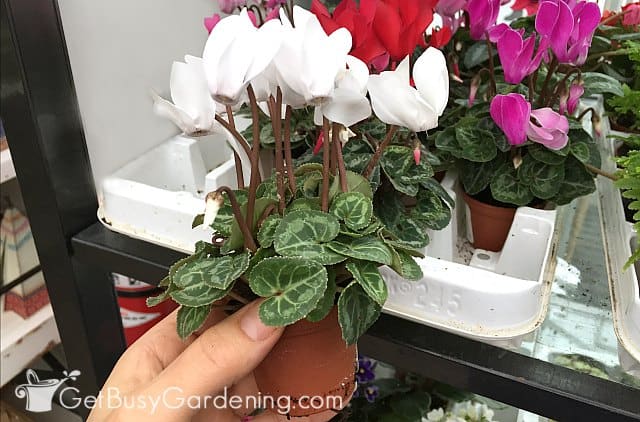
Cyclamen Life Cycle
Cyclamens have an opposite growing season than most plants. Since they bloom in the winter, it means that they thrive during the cooler months of the year, and go dormant in the heat of the summer.
That’s why they’re such popular gift plants around the holidays, and the reason they made my list of the top flowering houseplants.
However, it’s also the main cause for confusion on how to successfully grow them.
The biggest mistake people make with cyclamen care is trying to force them to grow year round. Most people don’t realize they need a period of rest in order to thrive.
Different Cyclamen Varieties
There are tons of beautiful cyclamen varieties and hybrids to choose from, and they all share similar care requirements. So whichever species you choose, you can’t go wrong. Here are some popular ones.
- Cyclamen persicum – Also called florist cyclamen, this is one of the most common varieties you can grow, but also the least cold hardy.
- Cyclamen purpurascens – The hardiest type of all, these can survive the winters outdoors all the way down to zone 3. But they hate the heat, and won’t do well in warmer climates.
- Cyclamen hederifolium – Another cold hardy variety, but only down to zone 5 outdoors. It blooms profusely in late winter/early spring, with lovely pink-purple flowers and gray-green mottled leaves.
- Cyclamen coum – This specimen has rounded dark green leaves which are marbled with silver, and the flowers can be anywhere from white, pink, or red.
Flowers
In nature, cyclamens flower during the winter, and go completely dormant in the summer. Indoors they follow a similar pattern.
Once open, the small fragrant blossoms dangle at the tops of tall skinny stems, which makes them appear to float above above the gorgeous heart shaped foliage.
They can be single or double, and some of them have ruffled edges, while others are rounded.
The delicate flowers come in a wide range of colors too, and can be anywhere from light, dark, or hot pink, white, red, purple, coral, and some even have white tips or margins.
Related Post: What To Do With Cyclamen After Flowering
Toxicity
A common question I get asked is: “are cyclamen plants poisonous?”. The short answer is yes. According to the ASPCA website the tubers are toxic to both cats and dogs when ingested.
So, if you have any pets or young children running around, it’s best to keep this one out of reach, just in case.
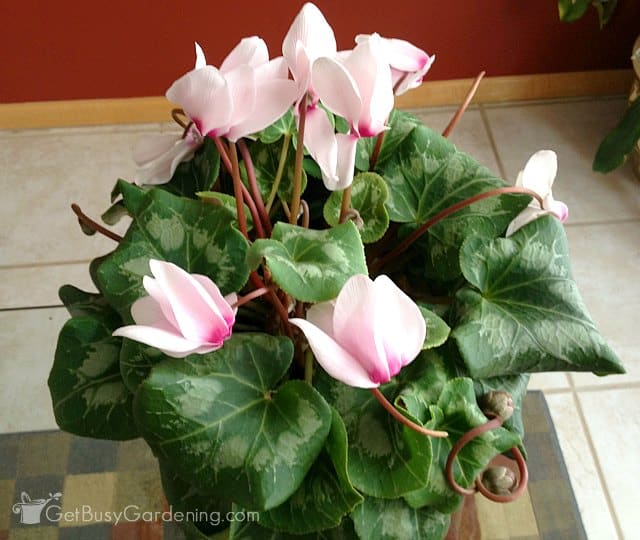
How To Care For Cyclamen
Before we dive into the detailed care requirements for cyclamen, first we need to discuss where to grow them. Choosing a good location is the first step for long-lasting health.
Hardiness
Though cyclamen are most commonly grown as houseplants, you might be surprised to learn that they’re perennials. They look tropical, but actually prefer cooler weather over heat.
Depending on the species, the hardiness can range anywhere from zones 3-11. That means that most gardeners can actually grow them outside in their garden. Woohoo!
However, it’s important to know which species you have, because some will only survive in warmer regions, while others require cold climates.
Where To Grow Cyclamens
Whether yours is in a pot or the ground, the ideal location for growing cyclamen is an area that gets partial shade or filtered sunlight, and stays cool during the winter.
Indoors they will do great in a bright room with indirect sunlight, or in an east or west facing window.
Outside they prefer a dry shady spot where they’ll be protected from the hot afternoon rays.
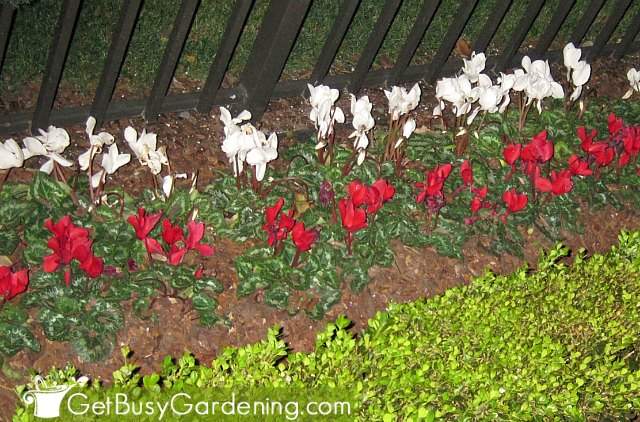
Cyclamen Plant Care & Growing Instructions
Now that you know where to grow them, it’s time to talk about the specifics of cyclamen plant care. The tips below will ensure you will be able to keep yours happy and healthy.
Cyclamen Temperature Tolerance
Cyclamens are very fussy about the temperature. They like to be kept cool during their active growing season (fall through spring). If they get too hot, it will force an early dormancy.
Indoors, keep them in a room where the temperature is between 50-70°F. The cooler they’re kept, the longer the flowers will last too.
They’re also sensitive to drafts, so avoid areas where hot or cold air blows (like near heat vents or drafty windows).
Providing the ideal cyclamen growing conditions outdoors is pretty easy during the winter, since it’s naturally cooler. Just protect them from the heat of the sun.

Watering
Proper cyclamen watering is a critical part of their care, and another thing that is a bit different than most plants.
Like African violets, they don’t like getting their leaves and stems wet. So it’s best to water them from the bottom, rather than over the top.
They like to stay evenly moist during their active growth period, and then dry out during summer. Consistent overwatering will kill them.
So allow yours to dry slightly between waterings, but never completely bone-dry. If you’re not sure how to keep them properly watered, I recommend getting a moisture gauge to help you out.
Using special pot that’s self-watering is perfect for growing cyclamen plants, and would be a great help to protect against overwatering.
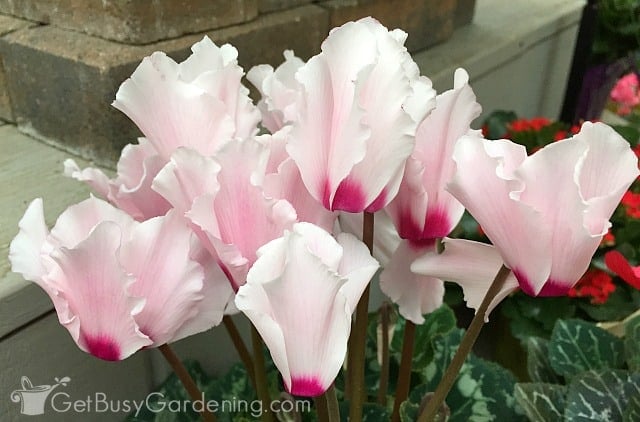
Humidity Requirements
Another important piece of successful cyclamen plant care is humidity. They like a lot of humidity, and this is especially important during the winter months.
To help increase the level around your cyclamen, you can run a humidifier nearby. You could also try putting it on top of a pebble tray filled with water.
To help you maintain the proper amount, try keeping an indoor humidity monitor near them to make sure the air doesn’t get too dry.
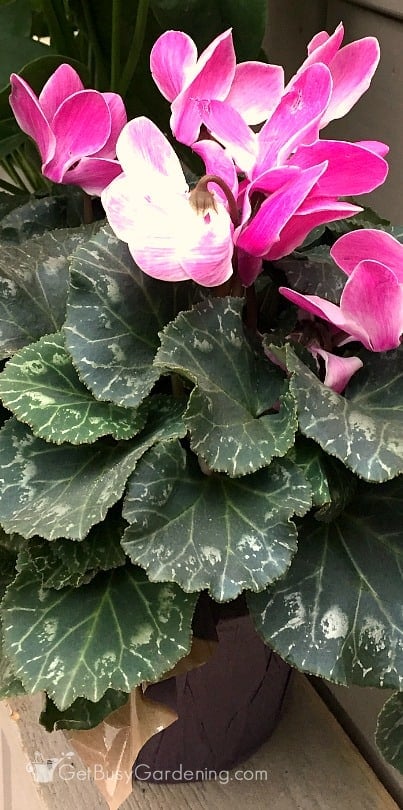
Light
Cyclamen plants like bright light, but they don’t like it hot, so take care to keep them out of the sun. Direct sunlight is too intense for them anyway, and can burn the leaves.
However, if they don’t get enough light, especially indoors, they can get tall and leggy. So find a spot where they’ll receive morning and evening sun, but be shaded from the strong afternoon rays.
A window with filtered light indoors, or a partial shade location outdoors are the best choices.
Soil
General purpose potting soil will usually work just fine for growing cyclamens, as long as it doesn’t hold too much moisture. If you tend to overwater, then use a fast draining mix instead.
You can always amend regular potting medium or clay garden soil with perlite or pumice and sand to give it better drainage.
Repotting
If your cyclamen has outgrown its container, you can repot it into a larger one. The best time for repotting is while they’re dormant.
Make sure to plant your cyclamen in the new pot at the same depth it was in the old one, and that it has adequate drainage.
Don’t bury the tubers too deep, they should be kept slightly above the soil line.
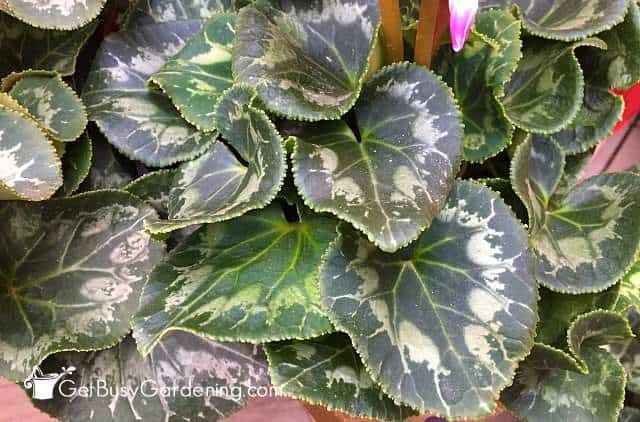
Fertilizer
You can fertilize your cyclamen using a weak half dose of liquid plant food every 2-4 weeks while it’s actively growing and blooming. Stop once the flowers begin to fade.
When you bring it out of dormancy, begin feeding again when it starts to put on new growth. A good rule of thumb is to only feed them while they have leaves.
They are very sensitive to chemicals, which can cause major damage. So I highly recommend using an organic option.
Compost tea, which you can get in liquid form or buy tea bags and brew your own, is a great choice. An organic flower fertilizer also works well, or use a general purpose one.
Pruning
Regular pruning is not a necessary part of cyclamen care. Normally the only time you’ll have to worry about it is as the flowers and foliage begin to fade and die back.
Simply snip off any dead or dying leaves and bloom stems at the base as needed using precision pruners. Once it’s completely died back, cut everything down to the soil line.

Pest Control Tips
Pests are rarely an issue with healthy cyclamen plants, but spider mites, aphids, thrips, or mealy bugs can sometimes attack them.
You can gently wipe the leaves with a damp cloth or one soaked with a natural insecticidal soap the help get rid of bugs.
Or spot-treat them by dabbing the insects with a cotton swab soaked in rubbing alcohol.
The leaves can be sensitive to sprays though. So to avoid damage, test them on one leaf for a few days before treating the whole plant, and don’t use any chemical products.
Dormancy
As I’ve mentioned before, cyclamen needs a period of dormancy as part of their annual care routine.
The catch is that it normally occurs during the summer, which is opposite than for most other plants.
Their natural cycle is that once the flowers fade, the leaves will start to die back and drop off.
Eventually the plant will die all the way back to the soil, and officially begin its rest period.
Unfortunately when this happens, most people think it’s dying or that they killed it, so they’ll throw it out.
However, this is a normal part of their life cycle, and just like amaryllis, they need it in order to bloom again.
So don’t toss it out when it starts to die back! With the proper care, you will be able to get your cyclamen to bloom again every year. Learn all about their dormancy and how to revive them here.
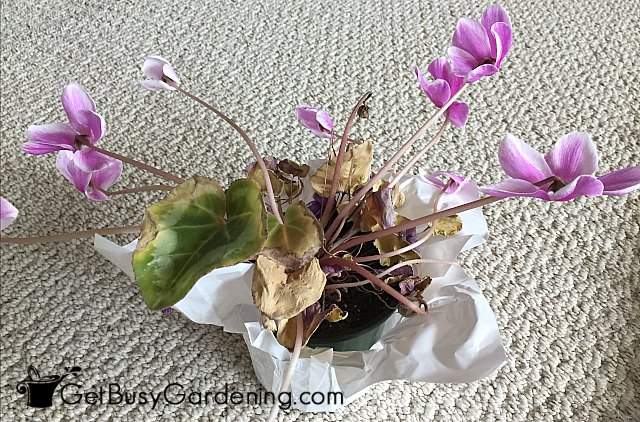
Cyclamen Propagation Tips
Cyclamen plants can easily be propagated by dividing the tubers and potting them into their own container. Each individual tuber will become a new plant.
They can also be grown from seed, and many times will sow themselves in the garden. But it can take a year or more before the new babies start to bloom.
So this method is definitely much slower than splitting mature ones.

Troubleshooting Common Cyclamen Care Problems
In this section, I’ll help you troubleshoot some of the most common cyclamen plant care problems. These tips will help you get yours back to health in no time.
Yellow Leaves
When the leaves start turning yellow, it can be a sign that your cyclamen is getting too hot. Move it to a cooler location, and keep it out of the direct sunlight.
If it has just finished blooming, then it’s probably going dormant, which is totally normal behavior. Learn all about the possible causes and how to fix yellow leaves here.
Flowers Drooping
Droopy leaves and flowers are usually caused by improper watering. Check the moisture level to make sure it’s not too wet or dry.
It’s also normal for the blooms to start drooping as they fade. In that case, cut them off at the base to help the others last longer.
Not Flowering
If your cyclamen is not flowering, that usually means it didn’t get a proper rest period. But it can also be caused by lack of nutrients, or the tubers were planted too deep.
First, ensure they get 2-3 months of full dormancy during the summer. If that’s not the problem, try giving them a dose of plant food during their active growth period.
Otherwise, repot or transplant them, ensuring the tops of the tubers stay slightly above the soil.
Foliage Looks Dirty Or Deformed
If the leaves or flowers look like they’re dirty, faded, or deformed, then it’s probably caused by bugs.
Gently wipe the leaves with a damp cloth soaked in water or insecticidal soap, but never spray anything on them.
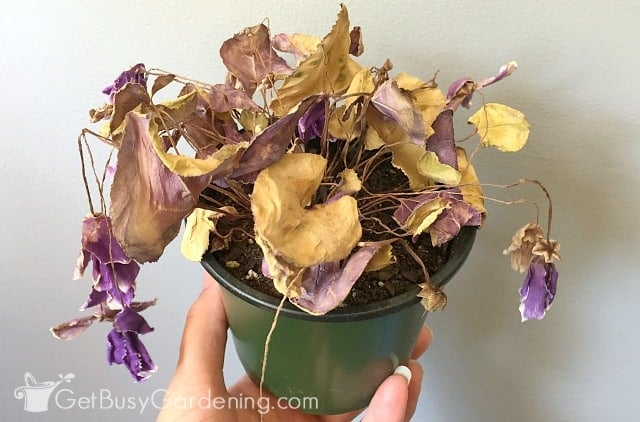
Cyclamen Care FAQs
In this section I’ll answer some of the most frequently asked questions about cyclamen care. If you can’t find yours here, then leave a comment below.
Do cyclamens grow back every year?
Yes, with the proper care, cyclamens will grow back every year indoors. Whether they will grow back outdoors depends on the hardiness of the specific variety you have, as well as your climate.
How long do cyclamen plants last?
On average, cyclamen flowers last for as long as 6-8 weeks. But some can bloom for up to 3 months in the ideal conditions. The plants themselves can live for decades.
Are cyclamens indoor or outdoor plants?
Cyclamens can be either indoor or outdoor plants. They will thrive as houseplants as long as they stay cool, and will survive outside in the proper climate.
Do cyclamens like shade or sun?
Cyclamens like shade, as the full sun is too hot for them. Indoors give them bright, indirect, or filtered sunlight from an east or west facing window.
Can cyclamen be planted outside?
Yes, cyclamens can be planted outside and can grow there year round as long as the variety you have is hardy in your zone. Plant them in a full or partial shade location where they’ll be protected from the hot afternoon sun.
Where do cyclamen grow best?
Cyclamen grow best in a humid, shady location with free-draining soil where they will stay cool, especially during the winter.
With proper cyclamen plant care, these beauties will bloom every year around Christmas time. Now that you know how to grow them, you’ll be able to enjoy the flowers for many years to come.
If you want to learn all there is to know about maintaining healthy indoor plants, then you need my Houseplant Care eBook. It will show you everything you need to know about how to keep every plant in your home thriving. Download your copy now!
More Holiday Plant Care Guides
- How To Care For Poinsettia Plants
- How To Care For A Thanksgiving Cactus (Schlumbergera truncata)
- How To Care For A Holiday Cactus Plus Growing Tips
- How To Care For An Easter Cactus Plant (Schlumbergera gaertneri)
- How To Care For A Christmas Cactus Plant (Schlumbergera buckleyi)
Share you cyclamen care tips in the comments section below.
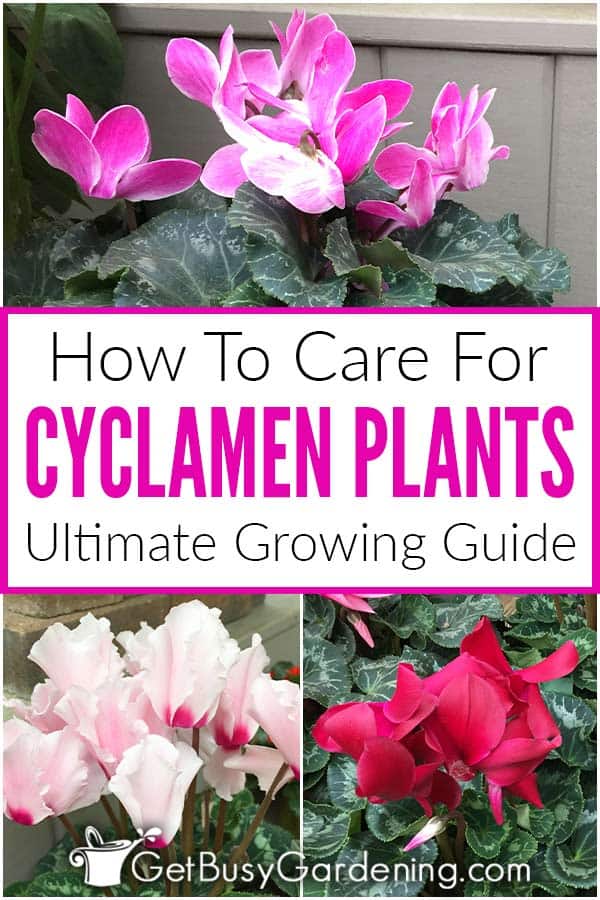
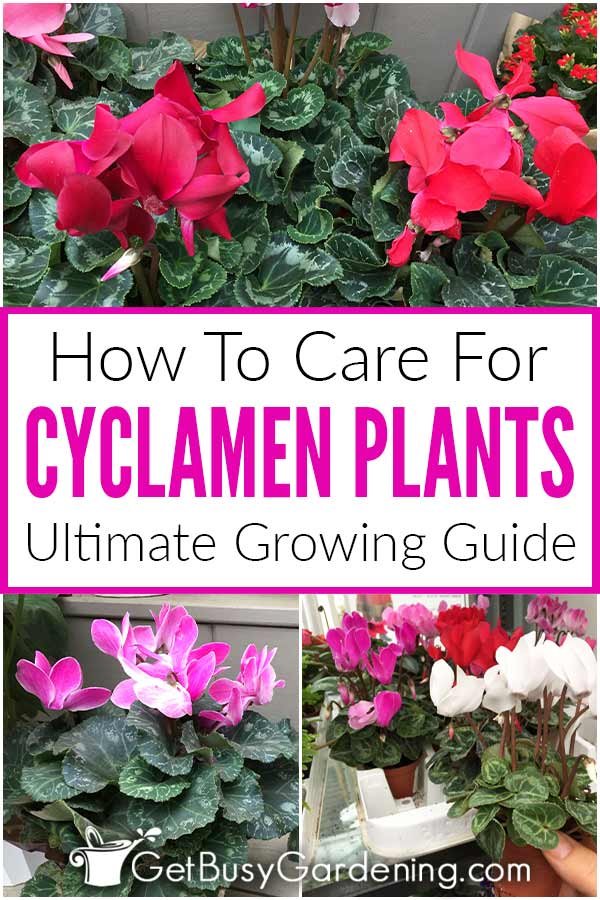
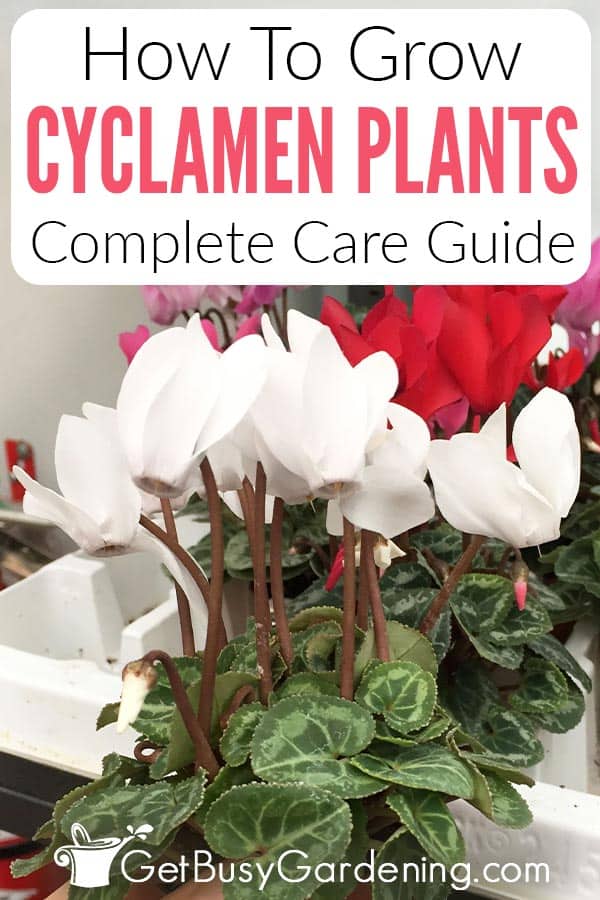
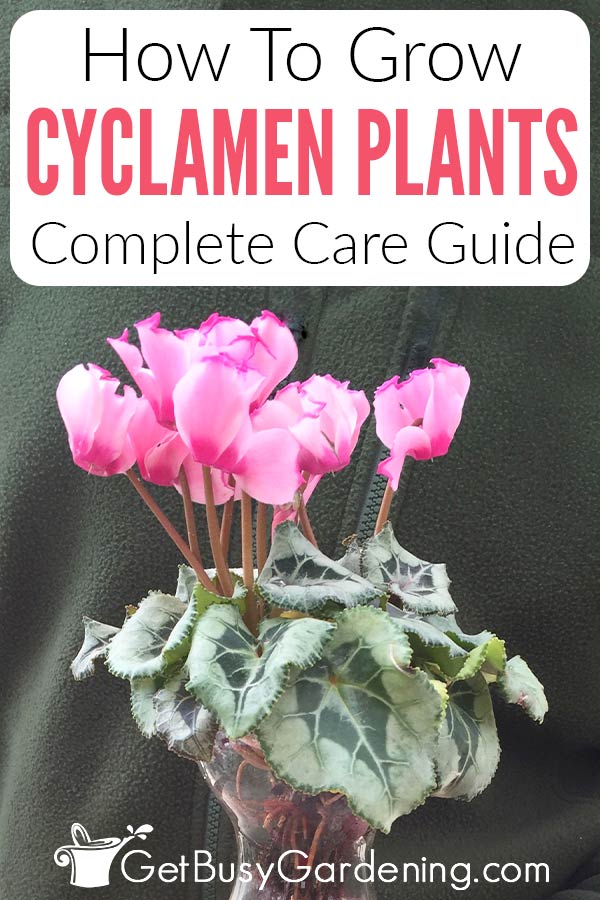

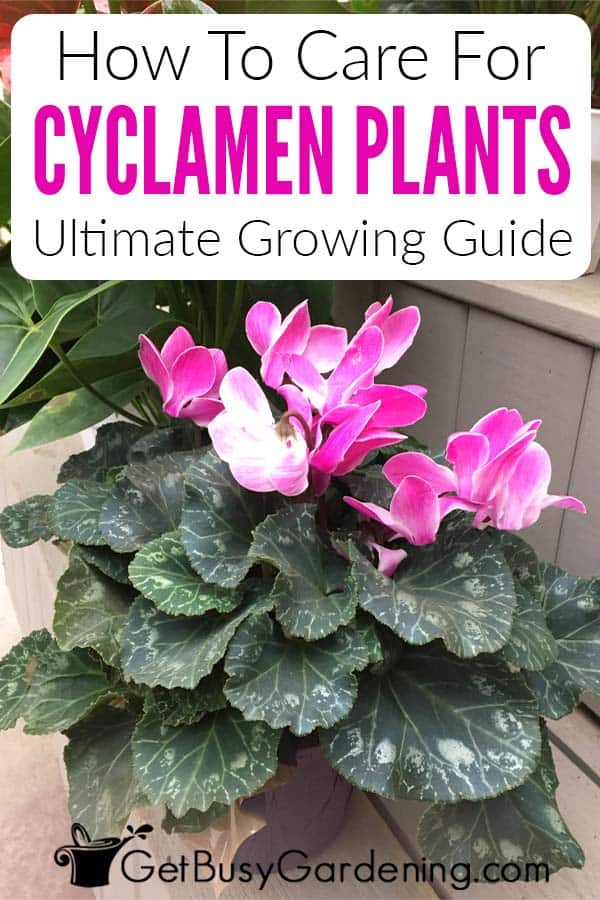



Nona Lindhorst says
Thank you for the information. I almost threw my cyclamen away, everything had shriveled away and I thought I had killed another one (first one died of over watering RIP), but I saw that I had one leaf that was still “healthy” so I came here to see what I had done wrong before I threw another one away, well needless to say my plant thanks you from being thrown out into the very cold, cold, cold pre-spring of WI
Amy Andrychowicz says
Wonderful, glad I could help! Hope your cyclamen will survive dormancy, and grow great for you again this year! 🙂
Kathleen Bowers Pinette says
I did not know that the cyclamen needs a dormancy period and so have been keeping mine going for well over two years. The “stem: where the leaves are growing from has grown 3 inches high. If I stop watering her for now and allow that to die off, would that take care of the very high leaf stem. IT’s not the bulb itself, just where the leaves were growing out of. Thank you for any answers you can provide.
Amy Andrychowicz says
Sorry, but I’m not sure. Are you saying that your cyclamen is growing leggy? I’ve never kept mine growing for that long. But the plant should grow back full and thick, and also flower again after dormancy.
Tessa says
I was gifted a cyclamen plant about 3 years ago. During those 3 years I kept it directly in the window, as it loved the sun and it continuously grew flowers for those 3 years straight. I never looked into care guides for cyclamen plants because my plant never had any issues so I took care of it like any other common house plant and never had any concerns.
A couple months ago my cyclamen lost all it’s flowers. I figured it was a coincidence that the flowers all died at once and more would grow back, but they haven’t yet. However it’s growing new baby leaves every week and looks to be very healthy despite not having any flowers. I’ve never had any yellowing of the leaves and my cyclamen has never once went into dormancy out of the 3 years I’ve had it. Is it normal for a cyclamen not to go into dormancy? What are the chances that it’ll flower again?
Amy Andrychowicz says
Wow, that is fantastic that your cyclamen plant has grown and flowered for so long! Impressive. Yes, it is normal for cyclamens to go dormant and lose all of their leaves, and that usually happens every year. But since yours has new leaves growing, I would just prune out the dead flowers and keep doing what you’re doing to keep it growing!
Deb says
I received my plant as a gift at Easter. I am so amazed it was my center piece in all my holidays this year. It is beautiful. I can’t wait till the fall to buy all my friends one. Can you transpot a plant and share it.
Amy Andrychowicz says
If your cyclamen plant is large enough, you can divide the tubers (bulbs) and pot them up into new pots to share with your friends.
Bryon Alex Espie says
Thank you for all the information on cyclamen care. I live in Auckland New Zealand, in Gov’t assisted housing. My house can get to temperatures indoors in the summer of anywhere from 25 degrees centigrade to 33 degrees centigrade and in winter drop to as low as 3 degrees centigrade. I also have an ongoing problem within my Lounge and Master Bedroom of a leaky roof syndrome, consequently my home suffers from mild dampness issues in winter and high humidity levels in summer. I had purchased a small indoor cyclamen a little over a year ago now. It flowered nicely for one season but then the leaves started to go yellow. I thought that perhaps I was over watering it so I backed off a little. That didn’t seem to make any difference, so I then thought that perhaps it was the location it was in as I had it sitting atop a 5 shelf bookcase, so I moved it to a lower level and placed it on a mantle. It didn’t seem to make any difference what ever I did. I now realise after reading other comments of yours that it had probably just entered into it’s dormant stage. The problem is that not having known that at the time, thought it was dead so unfortunately allowed it to dry out completely. I have attempted rewatering it since, trying to revive it but it appears to be a waste of time.
Do you think there would be any chance now of ever reviving it again or should I just throw it away and perhaps start again?
Amy Andrychowicz says
Some varieties take long than others to come out of dormancy, so sometimes you have to be very patient. But, one easy way to tell if your cyclamen tubers are still alive, or if it’s time to toss them out is to check the tubers. To do that, remove the rootball from the pot, and gently brush away the dirt until you see the tuber(s). If they are firm and look healthy, then keep trying to break dormancy. On the other hand, if the cyclamen tubers are completely dried out (or non-existent), then you know it’s a lost cause. Good luck!
Hannah says
I just got around 13 cyclmen plants from work that we’re free! I was definitely unsure of what to do with them but they were just gonna throw them away and I thought they were way to pretty to waste so I found your article and I’m so glad I did! Thanks so much for all the info and help!
Amy Andrychowicz says
Wow, great score!! You’re welcome, and good luck caring for your new cyclamen plants! 🙂
Shirleymorton says
Why are the leaves sticky
Amy Andrychowicz says
Sticky cyclamen leaves is usually a sign of some kind of pest infestation. Houseplant scale, mealybugs or aphids are usually the culprit. Take a close look at the leaves, stems and flowers, and under the leaves to see if you spot any bugs. If so, begin treatment immediately.
Elizabeth Style says
Thank you for all the interesting info. I will try to rebloom my cyclamen. Our summer in my part of northern NSW Australia gets to 40+deg. Not sure how to keep them cool in dormancy! But I have had them flowering for months. I leave my cyclamens sitting in a few cm of water on a window sill facing east.
Amy Andrychowicz says
Awesome, good luck!
Julie says
Hi normally when I have a cyclamen it dies of like you said but this time I have had it sitting in a deep bowl of water where the roots don’t touch the bottom because it is suspended up the bowl ,my plant has been growing and producing new leaves may have stumbled on new way to grow them maybe next season they will flower again who would have thought I just keep bottom of bowl topped up with water it’s loving it.
Amy Andrychowicz says
Wow, that’s fantastic! Yes, maybe you stumbled on a new way of growing cyclamen year round! I would love to her if they end up blooming for you again with your method. So come back and let us know, if you think of it. Good luck!
TJ says
Sorry if this information is available elsewhere, but I haven’t found it, so I thought I’d see if I get a response here. I’m a recent cyclamen addict. I’ve successfully grown some cyclamen persicum from seed (2 of over 100 seeds survived to bloom if you can call that success). Fresh from the excitement of seeing my 3 year endeavor finally bloom, I’ve become inspired to try my hand at hardier varieties of cyclamen so I can plant them outside eventually. I’ve orderd several tubers from Breck’s bulb company and so far, the C Hederifolium and C Coum seem to be showing signs of life. They are sprouting new roots and the Hederifolium even has some scraggly leaves on top, but in my order, I received far more C Cilicium which have yet to show any signs of breaking dormancy. I’m mildly annoyed at Brecks as they sent the tubers when they should have already been breaking dormancy and starting to send up leaves and or flowers according to everything I’ve read. Is there such a thing as too late to break dormancy for one year? Should I dry them back out and hope they survive in their dormant state until next fall? Should I leave them in the moistened soil with the Coum and Hederifolium and hope that they break dormancy soon?
Amy Andrychowicz says
I’m not familiar with each of those varieties that you mention, so I’m not sure if some are just slower to break dormancy than others. I would just keep them in the soil and hope they break dormancy. You could also try contacting Brecks and see if they can give you more details about the specific variety. Sorry I can’t be of much help.
Hilda Campos says
I noticed a photo of the cyclamen in a vase in water. Is this another option? I like the idea to be able to see the water level, this is my first time with this beautiful plant.
Amy Andrychowicz says
I haven’t actually tried it myself, I took that photo when visiting a cyclamen plant breeder last year. But yes, he assured me that cyclamen are easy to grow in water. I would try using the same method as you would force bulbs like Amaryllis in water… by suspending the bulbs above the water, and allowing the roots to grow into the water. Don’t submerge the bulbs, or they will likely just rot. It would be a fun experiment, but I would only try it if you have an extra cyclamen plant to spare.
Cyndee Ament says
My flowers on the plant look shriveled or like something is eating it what could be wrong?
Amy Andrychowicz says
If the flowers are shriveling and dying, that’s probably because your cyclamen plant is starting to go into it’s natural dormancy period. But, if the flowers look healthy, but are being eaten by something, then I would inspect the plant for bugs.
Irene says
Thanks for the advice on how to look after cyclamens it was very helpful
Amy Andrychowicz says
You’re welcome! 🙂
Ivanka Di Felice says
Hi, thanks for all the info. I live in Tuscany and usually cyclamen stay outside all winter then go dormant (though I thought mine died hence chucked them, oops) will they rebloom in the spring or do they only bloom once a year?
thanks.
Amy Andrychowicz says
They will bloom continuously when they aren’t dormant. So, if yours have survived, then I would expect that they will rebloom again once they come out of dormancy, and continue blooming until they are ready for dormancy again.
Pat says
My ‘friend’ gave me a cyclamen plant for my birthday in June. Amazingly, it is still blooming. After your great advice, it might make it through to next year, even tho it’s flowering cycle seems to be back to front
Amy Andrychowicz says
How fun, what a great gift! Yes, it’s very common for blooming gift plants like cyclamen to be forced to bloom at abnormal times. It may take a year or two before the plant recovers from being forced, and gets back into a normal lifecycle. 🙂 Good luck, I hope your cyclamen will grow and bloom for years to come!
Carol ("Mimi") says
This is timely. A friend just gave me a cyclamen plant for Valentine’s Day. Thanks for the information.
Amy Andrychowicz says
Awesome! Enjoy your cyclamen plant. 🙂
Ivory says
These cyclamen flowers of yours are very beautiful, but I don’t buy these, because I always killed them no matter what. My thumb for sure is NOT green when it comes to growing cyclamen plants. Thanks for the tips.
Amy Andrychowicz says
LOL! Yes, it can take a bit of time to get the hang of caring for cyclamen plants. 🙂